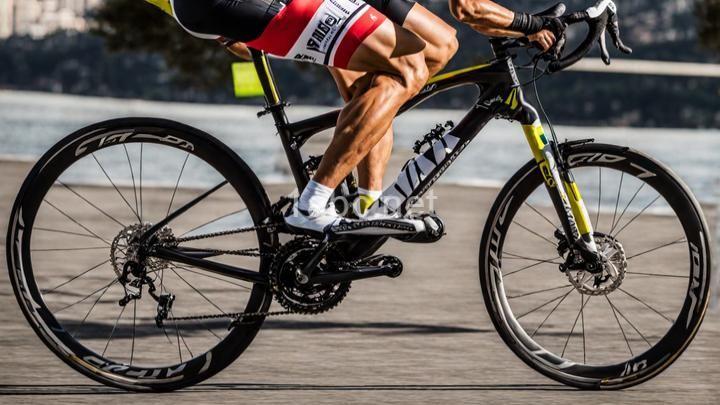A Guide to Preventing Lower Back Strain in Cyclists

Introduction:
Welcome to our friendly guide on preventing lower back strain in cyclists! Cycling is a great way to stay active and enjoy the outdoors, but it's important to take care of your body. In this guide, we'll provide you with tips and techniques to prevent lower back strain while cycling.
I. Understanding Lower Back Strain:
Lower back strain refers to the overstretching or tearing of muscles and tendons in the lower back region. It can be caused by various factors, including poor posture, improper bike fit, weak core muscles, and overuse. As a cyclist, it's crucial to address and prevent lower back strain to ensure a comfortable and pain-free ride.
II. Proper Bike Fit:
One of the key factors in preventing lower back strain is ensuring a proper bike fit. A bike that is not adjusted correctly can put unnecessary strain on your lower back. Here are some tips for achieving optimal posture and comfort:
-
Adjust your saddle height: When your foot is at the bottom of the pedal stroke, there should be a slight bend in your knee. If your leg is fully extended or too bent, it can lead to strain on your lower back.
-
Position your saddle fore and aft: The position of your saddle relative to the handlebars affects your posture. Experiment with moving your saddle forward or backward until you find a comfortable position that allows for a neutral spine.
-
Handlebar height: The height of your handlebars also plays a role in your posture. If the handlebars are too low, it can cause you to hunch over, putting strain on your lower back. Adjust the handlebar height to a position that allows for a relaxed and upright posture.
If you're unsure about how to adjust your bike properly, consider seeking professional help from a bike fitting specialist. They can analyze your riding position and make adjustments based on your body measurements and unique needs.
III. Core Strengthening Exercises:
Strong core muscles are essential for supporting the lower back and maintaining proper posture while cycling. Here are some simple exercises to incorporate into your routine:
-
Planks: Start in a push-up position, resting on your forearms and toes. Hold this position, keeping your body in a straight line from head to toe. Aim to hold for 30 seconds to 1 minute, gradually increasing the duration as you get stronger.
-
Deadbugs: Lie on your back with your arms extended towards the ceiling and your legs bent at a 90-degree angle. Slowly lower one arm and the opposite leg towards the floor while keeping your core engaged. Return to the starting position and repeat on the other side. Aim for 10-12 reps on each side.
-
Bridge exercises: Lie on your back with your knees bent and feet flat on the ground. Lift your hips off the ground, squeezing your glutes and engaging your core. Hold for a few seconds and then lower back down. Repeat for 10-12 reps.
These exercises can be done a few times a week to strengthen your core and improve your stability on the bike.
IV. Stretching Routine:
In addition to strengthening exercises, stretching plays a vital role in preventing lower back strain. It helps improve flexibility and range of motion, reducing the risk of muscle imbalances and tightness. Here are some stretches targeting the lower back and surrounding muscles:
-
Cat-camel stretch: Start on your hands and knees, with your back in a neutral position. Slowly arch your back up towards the ceiling (cat pose), and then lower it down towards the ground, creating a gentle curve (camel pose). Repeat this movement for 10-12 reps.
-
Child's pose: Kneel on the ground and sit back on your heels. Lower your torso towards the ground, reaching your arms forward and resting your forehead on the mat. Hold this position for 30 seconds to 1 minute, focusing on deep breathing and relaxation.
-
Piriformis stretch: Sit on the ground with one leg straight and the other leg crossed over it, placing the foot on the outside of the opposite knee. Gently twist towards the crossed leg, using your opposite arm to deepen the stretch. Hold for 30 seconds and repeat on the other side.
Incorporate these stretches into your warm-up routine before cycling and also after your ride to release any tension in the lower back and surrounding muscles.
V. Posture and Technique:
Maintaining correct posture and technique while cycling is crucial for reducing strain on the lower back. Here are some tips to keep in mind:
-
Maintain a neutral spine: Avoid rounding or arching your back while riding. Keep your back straight and your shoulders relaxed, allowing your core muscles to support your spine.
-
Engage your core muscles: Focus on actively engaging your core throughout your ride. This will help stabilize your spine and reduce the load on your lower back.
-
Adjust handlebar height: The height of your handlebars should be adjusted to allow for a comfortable and relaxed riding position. If you find yourself hunching over, consider raising the handlebars to reduce strain on your lower back.
VI. Gradual Progression and Recovery:
To prevent overuse injuries, including lower back strain, it's important to gradually increase your cycling intensity and distance. Gradually increase the duration and intensity of your rides, allowing your body time to adapt and recover.
Rest days are also crucial for recovery. Listen to your body and take regular breaks to give your muscles and joints time to rest and repair. Incorporate other forms of exercise, such as stretching or low-impact activities, on rest days to maintain overall fitness while giving your lower back a break.
Conclusion:
We hope this friendly guide has provided you with valuable insights into preventing lower back strain as a cyclist. By implementing these tips, you can enjoy cycling while keeping your lower back healthy and pain-free! Remember, always consult with a healthcare professional before starting any new exercise routine or if you experience persistent pain or discomfort. Happy cycling!
FREQUENTLY ASKED QUESTIONS
How can cycling cause lower back strain?
Cycling can cause lower back strain due to several factors. The position of the body while cycling can put pressure on the lower back, leading to discomfort and strain. The forward-leaning position, combined with repetitive pedaling motions, can cause the muscles in the lower back to become fatigued and overworked.Additionally, improper bike fit and technique can contribute to lower back strain. If the bike seat is too high or too low, it can disrupt the natural alignment of the spine and put excess stress on the lower back. Similarly, if the handlebars are positioned too far forward or too low, it can cause the rider to hunch over and strain their lower back.
It's also worth noting that cycling on uneven or rough surfaces can jolt the body, causing the lower back to absorb impact and potentially leading to strain or injury.
To help prevent lower back strain while cycling, it's important to ensure proper bike fit and technique. Adjusting the seat height and handlebar position to maintain a neutral spine alignment can help alleviate stress on the lower back. Strengthening the core muscles through exercises like planks and back extensions can also provide stability and support to the lower back while cycling.
Taking breaks and stretching regularly during long rides can help prevent muscle fatigue and reduce the risk of lower back strain. If you're experiencing persistent or severe lower back pain while cycling, it's advisable to consult a healthcare professional for a proper assessment and guidance.
How can I prevent lower back strain while cycling?
To prevent lower back strain while cycling, there are several steps you can take:
-
Ensure proper bike fit: Make sure your bike is set up correctly for your body. Adjust the saddle height, handlebar position, and reach to maintain a neutral spine position while riding.
-
Strengthen your core muscles: Having a strong core can provide stability and support for your lower back. Incorporate exercises like planks, bridges, and Russian twists into your fitness routine.
-
Improve your posture: Maintain good posture while cycling by keeping your back straight and shoulders relaxed. Avoid rounding your back or hunching over the handlebars.
-
Warm up and stretch: Before hopping on your bike, warm up your muscles with light cardio exercises and perform stretches that target your lower back, hamstrings, and hip flexors.
-
Listen to your body: Pay attention to any discomfort or pain in your lower back while cycling. If you start to feel strain, take a break, adjust your position, or try different techniques to alleviate the discomfort.
-
Take regular breaks: Long rides can put stress on your lower back. Take breaks every hour or so to stretch and rest your muscles.
-
Gradually increase intensity: If you're new to cycling or returning after a break, gradually increase your cycling intensity to allow your body to adapt and avoid sudden strains on your lower back.
Remember, it's always a good idea to consult with a healthcare professional or a certified bike fitter for personalized advice and guidance based on your specific needs and condition. Enjoy your rides and keep your lower back happy and healthy!
How do I know if my bike is properly fitted?
To determine if your bike is properly fitted, there are a few key factors to consider. Firstly, check your saddle height. When sitting on your bike, your legs should have a slight bend at the bottom of the pedal stroke. If your legs are fully extended or too bent, it may indicate that your saddle height needs adjustment.
Next, evaluate your saddle position. The saddle should be level or slightly tilted downward at the front. If it is tilted too far forward or back, it can cause discomfort and affect your riding efficiency.
Another important aspect is the reach to your handlebars. You should be able to comfortably reach the handlebars without straining or feeling too stretched out. If you find yourself leaning too far forward or feeling cramped, it may be a sign that your handlebar position needs adjustment.
Furthermore, pay attention to your pedal and shoe interface. Your foot should be properly aligned with the pedal and your shoe should fit securely. A misalignment or loose fitting can lead to discomfort and decreased power transfer.
Lastly, consider the overall comfort of your ride. Are you experiencing any pain or discomfort in your neck, back, or knees? These could be indicators of an improper bike fit.
If you're unsure about any of these factors, it's always a good idea to consult a professional bike fitter. They have the expertise to assess your bike fit and make necessary adjustments to ensure optimal comfort and performance.
Remember, a properly fitted bike can greatly enhance your riding experience, prevent injuries, and improve efficiency. So, take the time to evaluate and adjust your bike fit as needed. Happy riding!
Are there specific exercises that can help prevent lower back strain?
Yes, there are specific exercises that can help prevent lower back strain. Strengthening the muscles in your core, hips, and legs can provide support to your lower back and reduce the risk of strain. Some effective exercises include:
-
Planks: This exercise targets the entire core, including the muscles in your back. Start by lying face down on the floor, then lift your body off the ground using your forearms and toes. Keep your body in a straight line and hold this position for 30 seconds to a minute.
-
Bird Dogs: This exercise focuses on the muscles in your back and hips. Begin on all fours, then extend your right arm forward while simultaneously extending your left leg behind you. Hold this position for a few seconds, then switch sides. Repeat this movement for 10-15 repetitions on each side.
-
Bridge Pose: This exercise targets the muscles in your glutes and hamstrings, which can help stabilize your lower back. Lie on your back with your knees bent and feet flat on the floor. Press your feet into the ground, lift your hips off the floor, and squeeze your glutes. Hold this position for a few seconds, then lower your hips back down. Repeat for 10-15 repetitions.
-
Deadlifts: This exercise strengthens the muscles in your legs and back. Stand with your feet hip-width apart and a barbell in front of you. Hinge at your hips, keeping your back straight, and grip the barbell with an overhand grip. Lift the barbell by standing up, then lower it back down with control. Start with a lighter weight and gradually increase as you become more comfortable with the movement.
Remember to always maintain proper form and listen to your body. If you experience any pain or discomfort during these exercises, stop immediately and consult with a healthcare professional. Regularly incorporating these exercises into your fitness routine can help prevent lower back strain and promote a strong, healthy back.



